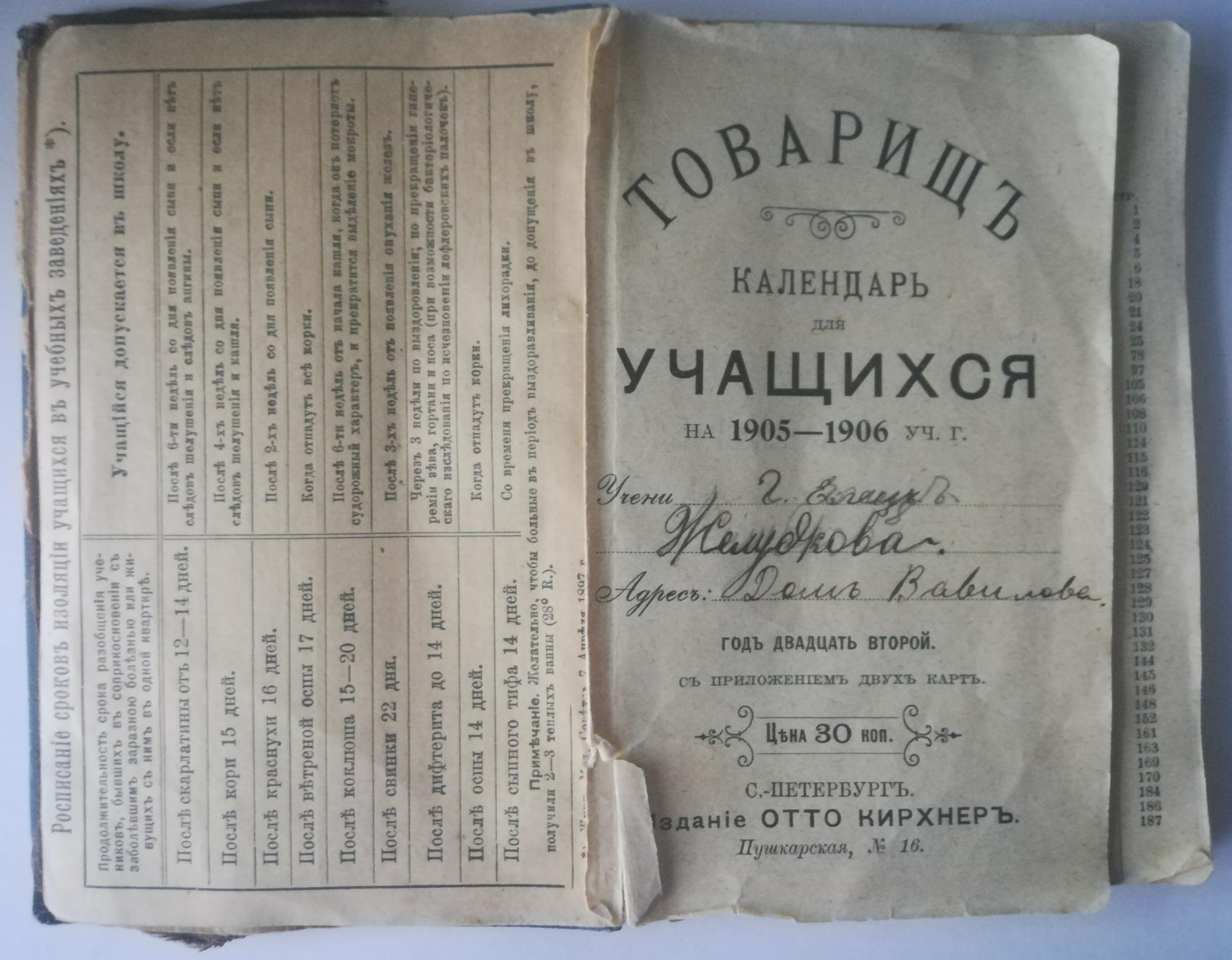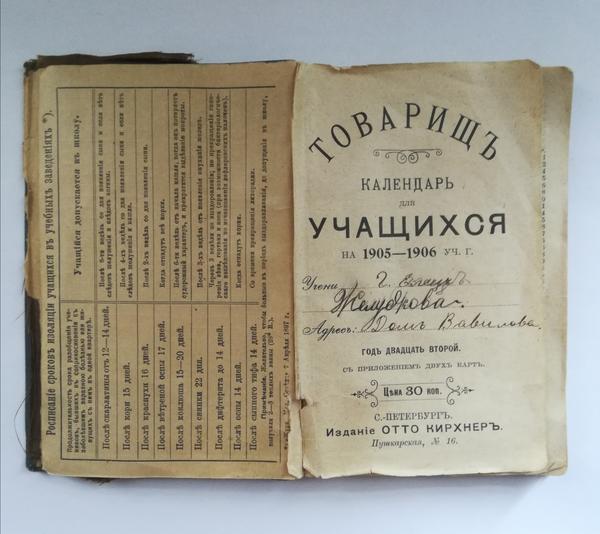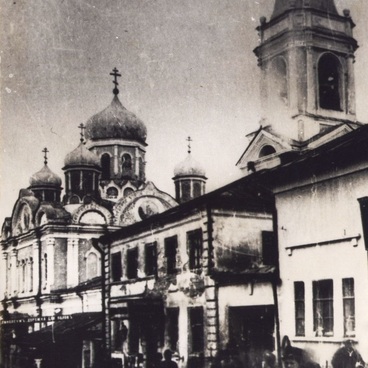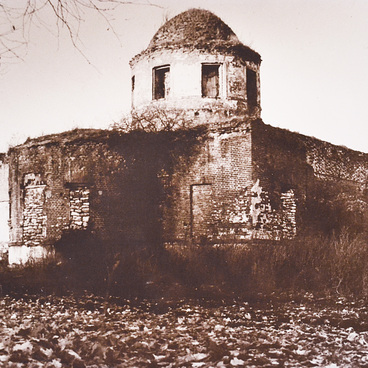At the beginning of the last century, many gymnasium students used so-called calendars or notebooks for students instead of the ordinary academic diaries we are used to. In the first page of the calendar the student could read the duration of isolation periods for students after infectious diseases. Scarlet fever, measles, rubella, chickenpox, diphtheria, typhoid — all these diseases were the scourges of that time, and every student had to know when it would be possible to go back to school after contact with the patient.
In total, the calendar had 238 pages and 72 sections, including the schedule of the lessons, and essay topics, a spelling guide, multiplication tables and wise sayings. Every major religious holiday, as well as any event in the royal family, was considered a day off. The calendar also included holidays of other confessions: Lutheran, Armenian-Gregorian, Jewish, and Muslim. The sections ‘Who I owe to and who owes me’, ‘Income - Expenses’, ‘Monthly totals’ were useful as the basics of accounting. A spelling guide, hyphenation rules, and a spelling dictionary helped developing literacy. Multiplication tables, table of squares and cubes for the first hundred of numbers, basic mathematical formulas were necessary for math lessons. From the calendar, one could learn how to convert meters to arshins, centimeters to inches, versts to kilometers. One of the most useful sections for gymnasium students was the list of higher education institutions in Russia with tuition fees included.
Two pages of the calendar contained the entire genealogy of Russian sovereigns (from Ryurik to Nicholas II) and the entire Imperial house. The calendar ‘Comrade’ described the rules of military service, encouraged young people to take care of their health (the section ‘Don’t smoke! ’), to follow the wise sayings of Lev Tolstoy and other famous people, visit museums, art galleries, libraries. Today it’s highly unlikely to find rules of behavior on the Internet in calendars, but at that period of time the telegraph rules were quite relevant. The calendar also included train schedules and much more information that is not directly related to educational processes, but, of course, would be useful in life. The release of such calendars was stopped for several years. Only in 1931 a similar calendar was released - ‘Desk blotter calendar’. It still has some chapters like before, but most of them were about pioneers, five-year plans, in also contained the list of irregular German verbs, and the Constitution of the USSR. Since 1948 this calendar had been given the name ‘Comrade. Pioneer’s and student’s notebook’, since 1955 - ‘Comrade. Pioneer’s notebook’. The release was discontinued again. Since 1967 the calendar was published under the title “Comrade. Pioneer”s companion”, and under this name the calendar was published until 1983. The “Comrade” brand existed almost 100 years.
In total, the calendar had 238 pages and 72 sections, including the schedule of the lessons, and essay topics, a spelling guide, multiplication tables and wise sayings. Every major religious holiday, as well as any event in the royal family, was considered a day off. The calendar also included holidays of other confessions: Lutheran, Armenian-Gregorian, Jewish, and Muslim. The sections ‘Who I owe to and who owes me’, ‘Income - Expenses’, ‘Monthly totals’ were useful as the basics of accounting. A spelling guide, hyphenation rules, and a spelling dictionary helped developing literacy. Multiplication tables, table of squares and cubes for the first hundred of numbers, basic mathematical formulas were necessary for math lessons. From the calendar, one could learn how to convert meters to arshins, centimeters to inches, versts to kilometers. One of the most useful sections for gymnasium students was the list of higher education institutions in Russia with tuition fees included.
Two pages of the calendar contained the entire genealogy of Russian sovereigns (from Ryurik to Nicholas II) and the entire Imperial house. The calendar ‘Comrade’ described the rules of military service, encouraged young people to take care of their health (the section ‘Don’t smoke! ’), to follow the wise sayings of Lev Tolstoy and other famous people, visit museums, art galleries, libraries. Today it’s highly unlikely to find rules of behavior on the Internet in calendars, but at that period of time the telegraph rules were quite relevant. The calendar also included train schedules and much more information that is not directly related to educational processes, but, of course, would be useful in life. The release of such calendars was stopped for several years. Only in 1931 a similar calendar was released - ‘Desk blotter calendar’. It still has some chapters like before, but most of them were about pioneers, five-year plans, in also contained the list of irregular German verbs, and the Constitution of the USSR. Since 1948 this calendar had been given the name ‘Comrade. Pioneer’s and student’s notebook’, since 1955 - ‘Comrade. Pioneer’s notebook’. The release was discontinued again. Since 1967 the calendar was published under the title “Comrade. Pioneer”s companion”, and under this name the calendar was published until 1983. The “Comrade” brand existed almost 100 years.











